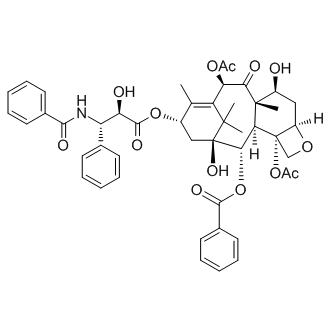| Cas No.: | 33069-62-4 |
| SMILES: | O(C(C)=O)[C@@]12CO[C@]1([H])C[C@H](O)[C@@]1(C)C(=O)[C@@H](C3=C(C)[C@H](C[C@](C3(C)C)([C@H]([C@]21[H])OC(C1C=CC=CC=1)=O)O)OC([C@@H]([C@H](C1C=CC=CC=1)NC(C1C=CC=CC=1)=O)O)=O)OC(C)=O |
| Formula: | C47H51NO14 |
| M.Wt: | 853.91 |
| Sotrage: | 2 years -20°C Powder, 2 weeks 4°C in DMSO, 6 months -80°C in DMSO |
| Description: | Paclitaxel is a potent anticancer medication which can promote microtubule (MT) assembly, inhibit MT depolymerization, and change MT dynamics required for mitosis and cell proliferation. |
| In Vivo: | In a SCID mouse xenograft model, low dose metronomic Paclitaxel treatment decreases lung dissemination of EGI-1 cells without significantly affecting their local tumor growth[3]. Low doses of paclitaxel promot liver metastasis in mouse xenografts, which correlats with changes in estrogen metabolism in the host liver[4]. Paclitaxel (2 mg/kg per treatment, black circles) induces mechanical hypersensitivity in the glabrous skin of the hindpaw[5]. |
| In Vitro: | Paclitaxel at 0.1, 0.5, and 1 μM reduces the proliferation and survival of CCRF-HSB-2 cells in a dose-dependent fashion and that the IC50 value of taxol is about 0.25 μM[1]. Paclitaxel directly associates with the endoplasmic reticulum to stimulate the release of calcium into the cytosol, contributing to the induction of apoptosis[2]. |

 To enhance service speed and avoid tariff delays, we've opened a US warehouse. All US orders ship directly from our US facility.
To enhance service speed and avoid tariff delays, we've opened a US warehouse. All US orders ship directly from our US facility.




















